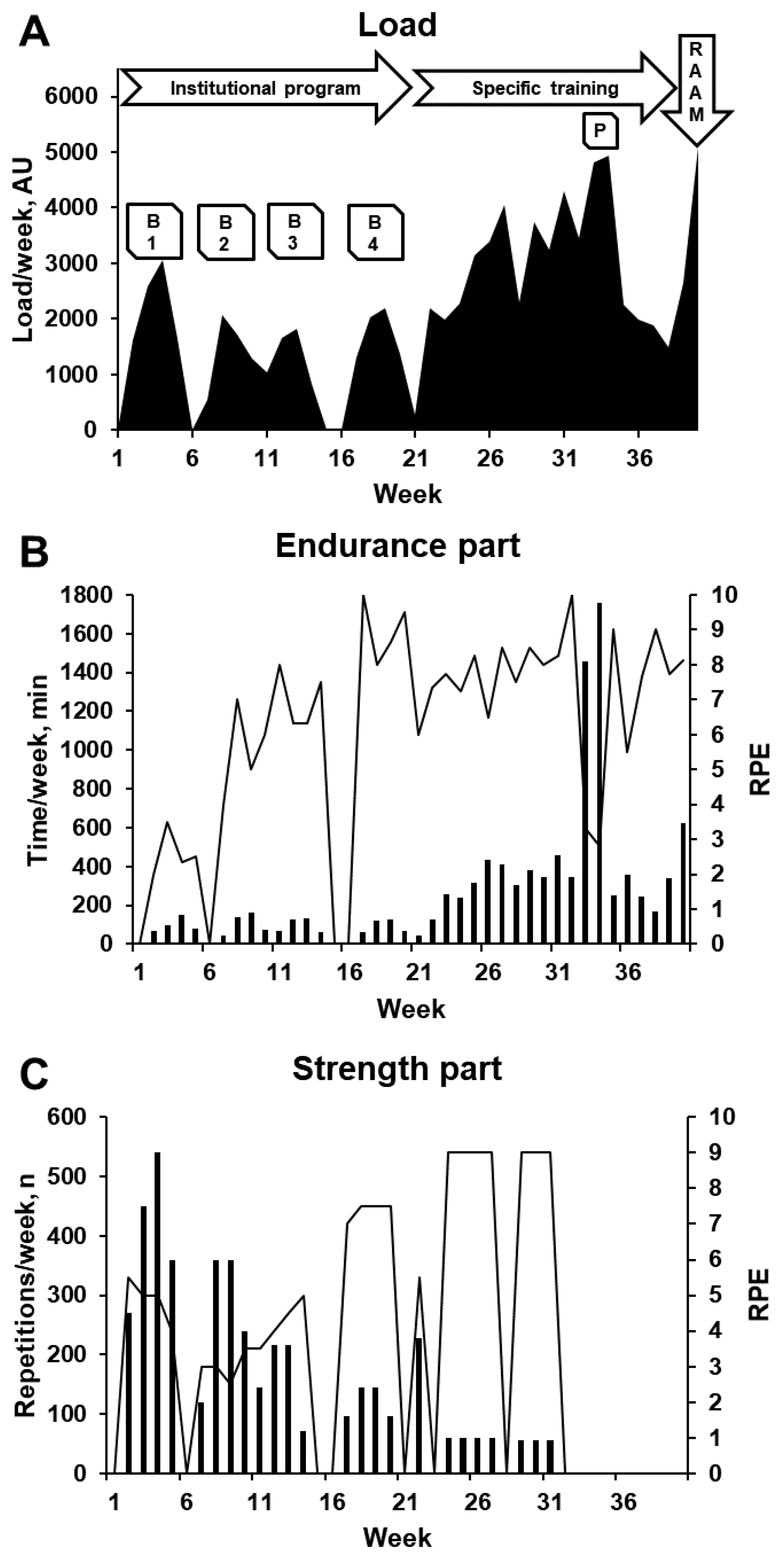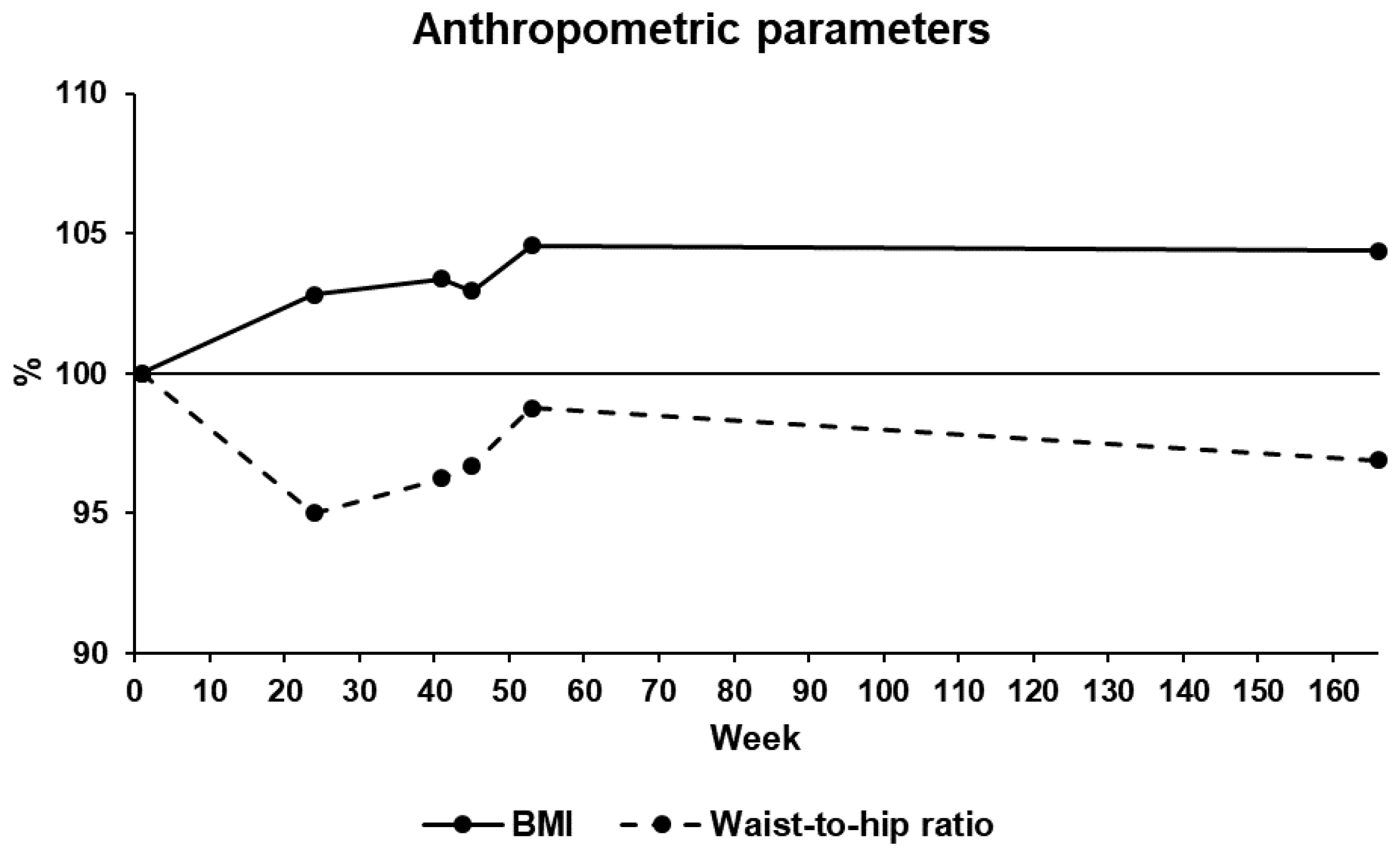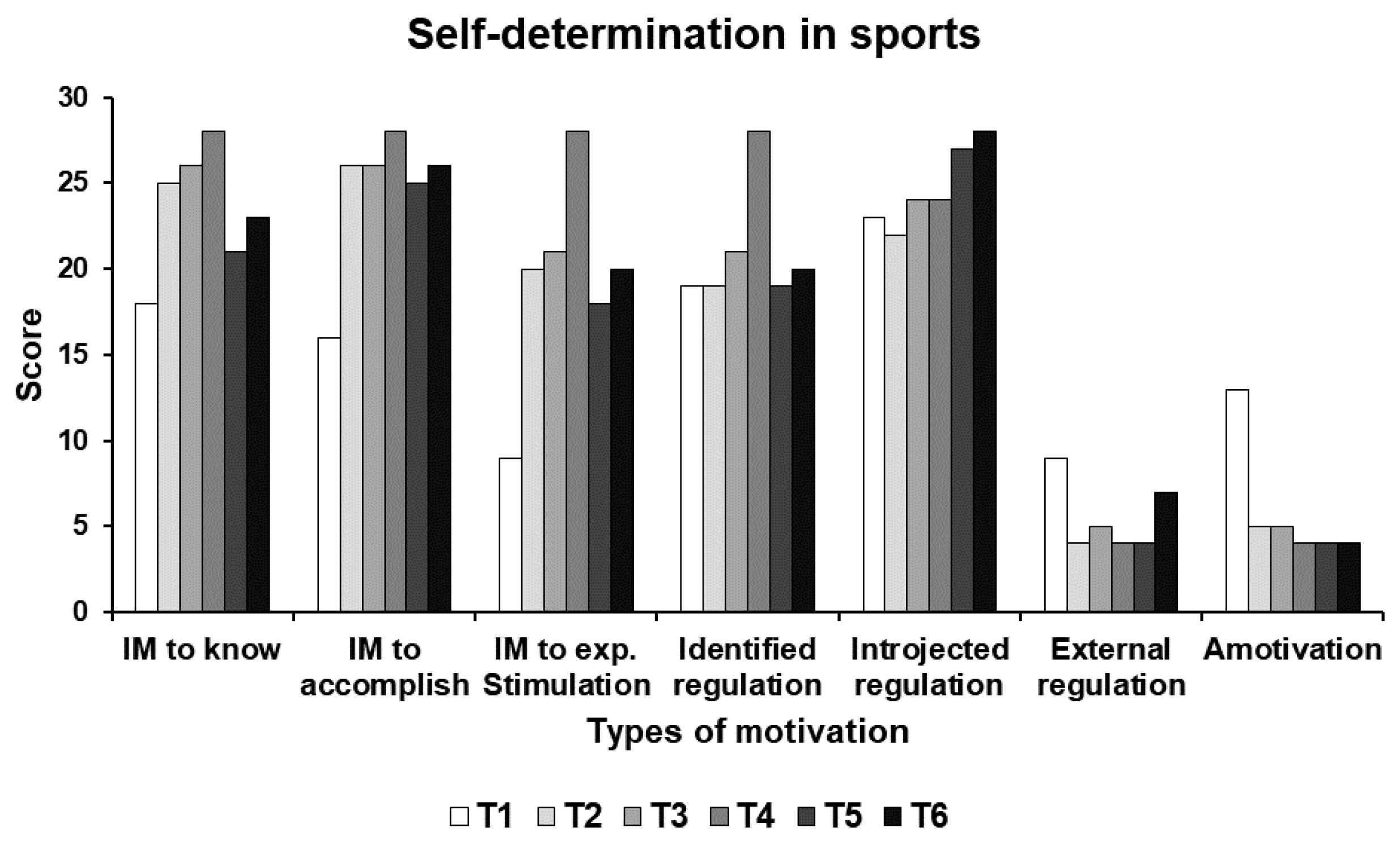From Sedentary and Physical Inactive Behaviours to an Ultra Cycling Race: A Mixed-Method Case Report
Abstract
:1. Introduction
2. Materials and Methods
2.1. Institutional PA program for Physically Inactive Students
2.2. Specific Cycling Training Program
2.3. Race across America
2.4. Monitoring of Workout Load
2.5. Follow-Up Period
2.6. Physiological Health Parameters
2.7. Psychological Health Parameters
2.8. Qualitative Aspects
3. Results
3.1. Physiological Health Parameters
3.2. Psychological Health Parameters
3.3. Qualitative Aspects
“A “no” must never come from us. If we must have a “no,” it must come from outside of us and not from within. We shouldn’t shoot ourselves in the foot or exclude our own selves.”
4. Discussion
4.1. Institutional PA Program for Physically Inactive Students
4.2. Cycling Specific Training Program
4.3. Race Across America
4.4. Follow-Up Period
4.5. Limitations
5. Conclusions
Author Contributions
Funding
Acknowledgments
Conflicts of Interest
References
- Matthews, C.E.; Chen, K.Y.; Freedson, P.S.; Buchowski, M.S.; Beech, B.M.; Pate, R.R.; Troiano, R.P. Amount of time spent in sedentary behaviors in the United States, 2003–2004. Am. J. Epidemiol. 2008, 167, 875–881. [Google Scholar] [CrossRef] [PubMed] [Green Version]
- Sedentary Behaviour Research Network. Letter to the editor: Standardized use of the terms “sedentary” and “sedentary behaviours”. Appl. Physiol. Nutr. Metab. 2012, 37, 540–542. [Google Scholar] [CrossRef] [PubMed] [Green Version]
- Tremblay, M.S.; Aubert, S.; Barnes, J.D.; Saunders, T.J.; Carson, V.; Latimer-Cheung, A.E.; Chastin, S.F.M.; Altenburg, T.M.; Chinapaw, M.J.M.; Participants, S.T.C.P. Sedentary Behavior Research Network (SBRN)—Terminology Consensus Project process and outcome. Int. J. Behav. Nutr. Phys. Act. 2017, 14, 75. [Google Scholar] [CrossRef] [PubMed] [Green Version]
- Lee, I.M.; Shiroma, E.J.; Lobelo, F.; Puska, P.; Blair, S.N.; Katzmarzyk, P.T.; Lancet Physical Activity Series Working Group. Effect of physical inactivity on major non-communicable diseases worldwide: An analysis of burden of disease and life expectancy. Lancet 2012, 380, 219–229. [Google Scholar] [CrossRef] [Green Version]
- Chau, J.Y.; Grunseit, A.C.; Chey, T.; Stamatakis, E.; Brown, W.J.; Matthews, C.E.; Bauman, A.E.; van der Ploeg, H.P. Daily sitting time and all-cause mortality: A meta-analysis. PLoS ONE 2013, 8, e80000. [Google Scholar] [CrossRef] [PubMed] [Green Version]
- WHO. Global Recommendations on Physical Activity for Health; World Health Organization: Geneva, Switzerland, 2010; pp. 23–27. [Google Scholar]
- Ekelund, U.; Steene-Johannessen, J.; Brown, W.J.; Fagerland, M.W.; Owen, N.; Powell, K.E.; Bauman, A.; Lee, I.M.; Lancet Physical Activity Series 2 Executive Committe; Lancet Sedentary Behaviour Working Group. Does physical activity attenuate, or even eliminate, the detrimental association of sitting time with mortality? A harmonised meta-analysis of data from more than 1 million men and women. Lancet 2016, 388, 1302–1310. [Google Scholar] [CrossRef] [Green Version]
- Rouse, P.C.; Biddle, S.J.H. An ecological momentary assessment of the physical activity and sedentary behaviour patterns of university students. Health Educ. J. 2010, 69, 116–125. [Google Scholar] [CrossRef] [Green Version]
- Peterson, N.E.; Sirard, J.R.; Kulbok, P.A.; DeBoer, M.D.; Erickson, J.M. Sedentary behavior and physical activity of young adult university students. Res. Nurs. Health 2018, 41, 30–38. [Google Scholar] [CrossRef] [PubMed]
- Lehmann, F.; von Lindeman, K.; Klewer, J.; Kugler, J. BMI, physical inactivity, cigarette and alcohol consumption in female nursing students: A 5-year comparison. BMC Med. Educ. 2014, 14, 82. [Google Scholar] [CrossRef] [Green Version]
- Irazusta, A.; Gil, S.; Ruiz, F.; Gondra, J.; Jauregi, A.; Irazusta, J.; Gil, J. Exercise, physical fitness, and dietary habits of first-year female nursing students. Biol. Res. Nurs. 2006, 7, 175–186. [Google Scholar] [CrossRef]
- McDowell, N.; McKenna, J.; Naylor, P.J. Factors that influence practice nurses to promote physical activity. Br. J. Sports Med. 1997, 31, 308–313. [Google Scholar] [CrossRef] [Green Version]
- Guex, K.; Serain, E.; Gremion, G.; Besson, C.; Faiss, R.; Majo, J.; Degache, F. Participating in the Race across AMerica in a Team of Eight Cyclists: Do Not Neglect Crew Preparation. Open Access J. Sports Med. 2019, 10, 161–169. [Google Scholar] [CrossRef] [PubMed] [Green Version]
- Shoak, M.A.; Knechtle, B.; Knechtle, P.; Rust, C.A.; Rosemann, T.; Lepers, R. Participation and performance trends in ultracycling. Open Access J. Sports Med. 2013, 4, 41–51. [Google Scholar] [CrossRef] [PubMed] [Green Version]
- Zingg, M.; Knechtle, B.; Rust, C.A.; Rosemann, T.; Lepers, R. Age and gender difference in non-drafting ultra-endurance cycling performance—The ‘Swiss Cycling Marathon’. Extrem. Physiol. Med. 2013, 2, 18. [Google Scholar] [CrossRef] [PubMed] [Green Version]
- Foster, C. Monitoring training in athletes with reference to overtraining syndrome. Med. Sci. Sports Exerc. 1998, 30, 1164–1168. [Google Scholar] [CrossRef] [PubMed]
- Foster, C.; Florhaug, J.A.; Franklin, J.; Gottschall, L.; Hrovatin, L.A.; Parker, S.; Doleshal, P.; Dodge, C. A new approach to monitoring exercise training. J. Strength Cond. Res. 2001, 15, 109–115. [Google Scholar]
- McGuigan, M.R.; Foster, C. A new approach to monitoring resistance training. Strength Cond. J. 2004, 26, 42–47. [Google Scholar] [CrossRef]
- Day, M.L.; McGuigan, M.R.; Brice, G.; Foster, C. Monitoring exercise intensity during resistance training using the session RPE scale. J. Strength Cond. Res. 2004, 18, 353–358. [Google Scholar] [CrossRef]
- Sweet, T.W.; Foster, C.; McGuigan, M.R.; Brice, G. Quantitation of resistance training using the session rating of perceived exertion method. J. Strength Cond. Res. 2004, 18, 796–802. [Google Scholar] [CrossRef] [Green Version]
- ACSM. ACSM’s Guidelines for Exercise Testing and Prescription, 9th ed.; Lippincott Williams & Wilkins: Philadelphia, PA, USA, 2014. [Google Scholar]
- Craig, C.L.; Marshall, A.L.; Sjostrom, M.; Bauman, A.E.; Booth, M.L.; Ainsworth, B.E.; Pratt, M.; Ekelund, U.; Yngve, A.; Sallis, J.F.; et al. International physical activity questionnaire: 12-country reliability and validity. Med. Sci. Sports Exerc. 2003, 35, 1381–1395. [Google Scholar] [CrossRef] [Green Version]
- McNair, D.M.; Lorr, M.; Droppleman, L.F. Revised Manual for the Profile of Mood States; Educational and Industrial Testing Services: San Diego, CA, USA, 1992. [Google Scholar]
- Brière, N.M.; Vallerand, R.J.; Blais, M.R.; Pelletier, L.G. Développement et Validation d’une Mesure de Motivation Intrinsèque, Extrinsèque et d’Amotivation en Contexte Sportif: L’Échelle de Motivation dans les Sports (ÉMS). Development and validation of a scale on intrinsic and extrinsic motivation and lack of motivation in sports: The Scale on Motivation in Sports. Int. J. Sport Psychol. 1995, 26, 465–489. [Google Scholar]
- Giorgi, A. An Application of Phenomenological Method in Psychology. Duquesne Stud. Phenomenol. Psychol. 1975, 2, 82–103. [Google Scholar] [CrossRef]
- Gerovasili, V.; Agaku, I.T.; Vardavas, C.I.; Filippidis, F.T. Levels of physical activity among adults 18–64 years old in 28 European countries. Prev. Med. 2015, 81, 87–91. [Google Scholar] [CrossRef] [Green Version]
- Murlasits, Z.; Kneffel, Z.; Thalib, L. The physiological effects of concurrent strength and endurance training sequence: A systematic review and meta-analysis. J. Sports Sci. 2018, 36, 1212–1219. [Google Scholar] [CrossRef] [PubMed]
- Yusuf, S.; Hawken, S.; Ounpuu, S.; Bautista, L.; Franzosi, M.G.; Commerford, P.; Lang, C.C.; Rumboldt, Z.; Onen, C.L.; Lisheng, L.; et al. Obesity and the risk of myocardial infarction in 27,000 participants from 52 countries: A case-control study. Lancet 2005, 366, 1640–1649. [Google Scholar] [CrossRef]
- Michie, S.; van Stralen, M.M.; West, R. The behaviour change wheel: A new method for characterising and designing behaviour change interventions. Implement Sci. 2011, 6, 42. [Google Scholar] [CrossRef] [Green Version]
- Vellers, H.L.; Kleeberger, S.R.; Lightfoot, J.T. Inter-individual variation in adaptations to endurance and resistance exercise training: Genetic approaches towards understanding a complex phenotype. Mamm. Genome 2018, 29, 48–62. [Google Scholar] [CrossRef] [Green Version]
- Bouchard, C.; Rankinen, T. Individual differences in response to regular physical activity. Med. Sci. Sports Exerc. 2001, 33, S446–S451. [Google Scholar] [CrossRef] [Green Version]
- Bouchard, C. Genomic predictors of trainability. Exp. Physiol. 2012, 97, 347–352. [Google Scholar] [CrossRef]
- O’Donovan, G.; Lee, I.M.; Hamer, M.; Stamatakis, E. Association of “Weekend Warrior” and Other Leisure Time Physical Activity Patterns with Risks for All-Cause, Cardiovascular Disease, and Cancer Mortality. JAMA Intern. Med. 2017, 177, 335–342. [Google Scholar] [CrossRef] [Green Version]
- Goodman, J.; Thomas, S.; Burr, J.F. Physical activity series: Cardiovascular risks of physical activity in apparently healthy individuals: Risk evaluation for exercise clearance and prescription. Can. Fam. Physician 2013, 59, 46–49. [Google Scholar] [PubMed]
- Deliens, T.; Deforche, B.; De Bourdeaudhuij, I.; Clarys, P. Determinants of physical activity and sedentary behaviour in university students: A qualitative study using focus group discussions. BMC Public Health 2015, 15, 201. [Google Scholar] [CrossRef] [PubMed] [Green Version]
- Gillet, N.; Vallerand, R.J. Les effets de la motivation sur la performance sportive au regard de la théorie de l’autodétermination: Vers une approche intra-individuelle. Psychol. Française 2016, 61, 257–271. [Google Scholar] [CrossRef]
- Biddle, S.J.; Chatzisarantis, N.; Hagger, M. Théorie de l’autodétermination dans le domaine du sport et de l’exercice physique. In Théories de la Motivation et Pratiques Sportives; Presses Universitaires de France: Paris, France, 2001; pp. 17–55. [Google Scholar]
- Jago, R.; Anderson, C.B.; Baranowski, T.; Watson, K. Adolescent patterns of physical activity differences by gender, day, and time of day. Am. J. Prev. Med. 2005, 28, 447–452. [Google Scholar] [CrossRef]
- McAuley, E.E.; Blissmer, B.; Marquez, D.X. L’efficacité personnelle: Un antécédent et une conséquence de l’activité physique. In Théories de la Motivation et Pratiques Sportives; Presses Universitaires de France: Paris, France, 2001; pp. 165–191. [Google Scholar]







| Block | Parameter | Strength Part | Endurance Part |
|---|---|---|---|
| 1 | Volume Intensity Rest | 1–3 × 15 reps 50%–60% 1-RM 1 min | 30–50 min 40%–60% MAP – 70%–85% MHR |
| 2 | Volume Intensity Rest | 2–3 × 10 reps 70%–80% 1-RM 2 min | 2–6 × 4–5 min 75%–80% MAP – 92%–96% MHR 4–5 min |
| 3 | Volume Intensity Rest | 2–3 × 6 reps 85% 1-RM 3 min | 2–3 × 6–9 × 30 s 100% MAP – 96%–100% MHR 30 s/5 min |
| 4 | Volume Intensity Rest | 2–3 × 4 reps 90% 1-RM 3 min | 3–4 × 4–6 × 6 s >250% MAP – 90%–95% MHR 6 s/5 min |
© 2020 by the authors. Licensee MDPI, Basel, Switzerland. This article is an open access article distributed under the terms and conditions of the Creative Commons Attribution (CC BY) license (http://creativecommons.org/licenses/by/4.0/).
Share and Cite
Guex, K.; Wicht, S.; Besson, C.; Degache, F.; Gojanovic, B.; Gremion, G. From Sedentary and Physical Inactive Behaviours to an Ultra Cycling Race: A Mixed-Method Case Report. Int. J. Environ. Res. Public Health 2020, 17, 502. https://0-doi-org.brum.beds.ac.uk/10.3390/ijerph17020502
Guex K, Wicht S, Besson C, Degache F, Gojanovic B, Gremion G. From Sedentary and Physical Inactive Behaviours to an Ultra Cycling Race: A Mixed-Method Case Report. International Journal of Environmental Research and Public Health. 2020; 17(2):502. https://0-doi-org.brum.beds.ac.uk/10.3390/ijerph17020502
Chicago/Turabian StyleGuex, Kenny, Sophie Wicht, Cyril Besson, Francis Degache, Boris Gojanovic, and Gerald Gremion. 2020. "From Sedentary and Physical Inactive Behaviours to an Ultra Cycling Race: A Mixed-Method Case Report" International Journal of Environmental Research and Public Health 17, no. 2: 502. https://0-doi-org.brum.beds.ac.uk/10.3390/ijerph17020502






